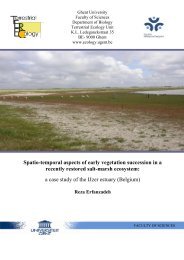PhD Arthur Decae 2010 - Ghent Ecology - Universiteit Gent
PhD Arthur Decae 2010 - Ghent Ecology - Universiteit Gent
PhD Arthur Decae 2010 - Ghent Ecology - Universiteit Gent
You also want an ePaper? Increase the reach of your titles
YUMPU automatically turns print PDFs into web optimized ePapers that Google loves.
cork- door, as built by the three above-mentioned species, the hinge is a narrow, ribbon-like<br />
silken strap that allows the door, when open, to rotate slightly. The trapdoors of both N. randa<br />
and N. bristowei, however, have a much broader silken hinge that limits the door to simple<br />
straightforward opening and closing movements. Like the burrow of all other species<br />
mentioned in this paragraph, the burrow of N. randa is a simple tube without side<br />
excavations.<br />
Behavior: In the field the burrows of N. randa may be found on rather horizontal and<br />
gradually sloping soil surfaces but, like N. bristowei, it is most frequently found on very<br />
steep or vertical clay walls. Particularly where N. randa is found syntopically with N. brauni<br />
there seems to be some habitat partitioning in which N. brauni predominantly occupies the<br />
more horizontal ground and N. randa the steeper surfaces. A curious observation, that so far<br />
has no clear explanation, is that whereas most trapdoor spider species orient their trapdoors<br />
in the same position with respect to the slope of the terrain, N. randa orients its door<br />
differently. In most trapdoor spiders the hinge connects the trapdoor to the highest (most<br />
uphill) point of the burrow entrance and the door opens widely facing downhill, but in N.<br />
randa the trapdoor almost invariably opens sideways with respect to the slope, or even uphill<br />
(also observed though less frequently in N. bristowei). In temperament N. randa is a rather<br />
un-aggressive spider that will bite only as a last defense after capture. It is also "shy" in its<br />
hunting posture, which is essentially similar to that described for N. bristowei (Fig. 78). The<br />
prey capture range of N. randa, owing to the spider's larger size, extends to a somewhat<br />
greater distance of about 2 cm from the burrow rim. Prey handling and the ejection of preyremains<br />
and feces from the burrow are as described for N. bristowei. In captivity N. randa<br />
was found to be more reluctant to construct a new burrow than the other Majorcan Nemesia<br />
species. Some spiders wandered around their clay-filled containers for weeks before they<br />
finally started digging, and some never dug. When the spiders finally constructed a burrow, it<br />
was indistinguishable from a natural burrow, and usually the spiders were found hunting<br />
normally the night after the construction work was finished. In captivity N. randa would take<br />
a wide range of arthropod prey, but none larger than about half the size of the spider. As N.<br />
bristowei, and in contrast to N. brauni and N. seldeni, N. randa was never seen to leave the<br />
burrow in pursuit of prey.<br />
Distribution (Fig. 84): Nemesia randa was found to have a restricted distribution on Majorca,<br />
where it is common around the central massif of the Massis de Randa and in the south-eastern<br />
parts of the island. It inhabits similar habitats to N. brauni, with which species it is sometimes<br />
found in close association.<br />
Nemesia santeugenia sp. n. (Figs. 40-46, 71, 86)<br />
Types: Holotype ♀ (AR 14197), 1 April 1997, Majorca, Santa Eugenia, 39.611°N, 2.876°E,<br />
burrow in horizontal ground on edge of pine growth. Paratype: 1 ♀ (9972.4014), Majorca,<br />
Bon Ani, 39.590°N, 3.082°E, 16 October 2000, burrow in sloping ground on hillside pine<br />
forest. Both leg. A. E. <strong>Decae</strong>.<br />
Etymology: The specific name is a noun in apposition taken from the village Santa Eugenia,<br />
in the vicinity of which it was first found on Majorca.<br />
Diagnosis: Nemesia santeugenia is a medium to large sized Nemesia species from Majorca<br />
that shares a characteristic type of spermathecae with N. santeulalia sp. n. from Ibiza (cf.<br />
Figs. 46 and 60). The spermathecae are compact (without a clear division between proximal<br />
and distal parts), short, more or less "potato- shaped" and densely covered with glandular<br />
tissue over their total surface. In their external morphology N. santeugenia and N. santeulalia<br />
are also very similar, although some differences were observed in the relative sizes of ALE<br />
and PLE (ALE/PLE= 1.2-1.4 (n=2) for N. santeugenia and ALE/PLE=0.9-1.2 (n=6) for N.










